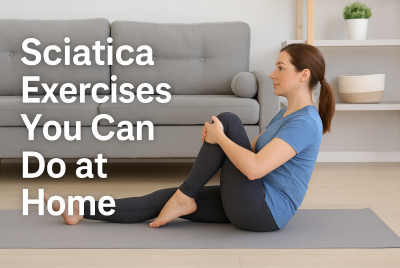Lifestyle Changes to Stop Sciatica from Returning – Long-Term Habits for Lasting Nerve Health and Pain-Free Living
⚡ The Frustration of Recurring Sciatica
If you’ve ever felt the sharp, shooting pain of sciatica, you know how much it can limit your life. One moment you’re fine, the next — a simple twist, step, or long car ride reignites that deep ache down your leg. For many people, the hardest part isn’t the first flare-up — it’s the cycle of recurring pain. Sciatica can fade for months, only to return when your posture slips, stress builds up, or your daily habits drift off track. The good news? You have more control than you think.
By making a few targeted lifestyle changes to stop sciatica returning, you can protect your back, calm your nerves, and reclaim comfort — naturally.
🧠 Why Sciatica Comes Back (and What You Can Do About It)
Sciatica is caused by compression or irritation of the sciatic nerve, which runs from the lower spine through the hips, buttocks, and down the legs. Once this nerve becomes inflamed, it’s prone to re-aggravation if you don’t address the root causes.
Common Triggers for Recurring Sciatica:
-
Prolonged sitting or poor posture
-
Weak core or back muscles
-
Inactivity or sudden overexertion
-
Weight gain or inflammation
-
Stress-related muscle tension
👉 The key to prevention isn’t avoiding movement — it’s moving smarter, strengthening your support muscles, and balancing your lifestyle.
💪 1. Build Stronger Core and Back Muscles
Your core is your spine’s armor. Weak abdominal and lower back muscles leave your sciatic nerve vulnerable to compression.
✅ Simple Home Exercises for Prevention
-
Pelvic Tilts – Strengthen lower back and abdominals
-
Bridges – Activate glutes and stabilize hips
-
Cat-Cow Stretch – Improve spine flexibility
-
Planks (modified or wall planks) – Build gentle core endurance
🧘♀️ Tip: Start with 10–15 minutes daily. Over time, these gentle movements retrain your body to hold proper posture without strain.
🧘♀️ 2. Improve Daily Movement Habits
Even healthy people can irritate their sciatic nerve through poor movement mechanics.
🌿 Movement Habits That Help:
-
Avoid long sitting sessions — Stand or stretch every 30 minutes.
-
Lift safely — Bend your knees, not your waist.
-
Alternate positions — Switch between sitting, standing, and walking throughout your day.
-
Sleep smart — Try side-sleeping with a pillow between your knees for spinal alignment.
💡 U.S. Tip: Invest in an ergonomic standing desk (like the FlexiSpot E7) and a lumbar cushion (ComfiLife Gel Support Pillow) to protect your lower back during long work hours.
🥗 3. Follow an Anti-Inflammatory Diet
What you eat directly affects how your body manages pain. Chronic inflammation can make sciatica flare-ups more frequent and more severe.
✅ Foods That Support Nerve and Joint Health
-
Omega-3s: Salmon, sardines, chia seeds, walnuts
-
Antioxidants: Blueberries, spinach, kale
-
Turmeric & Ginger: Reduce inflammation naturally
-
Magnesium-rich foods: Avocados, bananas, almonds
❌ Foods to Limit
-
Refined sugars
-
Processed meats
-
Trans fats
-
Excess alcohol
🌿 Bonus Tip: A daily supplement like Nature Made Magnesium Glycinate or Garden of Life Turmeric & Ginger may support joint flexibility and nerve health.
🧘♂️ 4. Manage Stress to Protect Your Nerves
Stress doesn’t just affect your mind — it tightens muscles, constricts blood flow, and increases inflammation.
This tension often settles in the lower back and hips, triggering sciatica.
🌬️ Stress-Reduction Habits
-
Deep breathing (4-7-8 method): Calm the nervous system
-
Meditation or mindfulness apps: Try Calm or Headspace
-
Gentle yoga or tai chi: Improves flexibility and mental clarity
-
Walking outdoors: Reduces cortisol and releases endorphins
🧠 Fun fact: Studies show that people who practice mindfulness-based stress reduction (MBSR) report up to 40% less chronic pain after eight weeks.
🦶 5. Choose Footwear That Supports Spinal Alignment
Your feet are your foundation. Wearing unsupportive shoes can throw off your posture and aggravate your sciatic nerve.
👟 Footwear Tips
-
Look for shoes with arch support and cushioned soles
-
Avoid high heels or flat shoes with no padding
-
Replace worn-out sneakers every 6–12 months
Recommended options for U.S. readers:
-
HOKA Bondi 8 – maximum shock absorption
-
Skechers Arch Fit – budget-friendly orthopedic support
-
Orthofeet Coral – designed for chronic pain and sciatica relief
🛋️ 6. Prioritize Posture — Sitting, Standing & Sleeping
Small posture changes add up to big pain relief. Poor spinal alignment is one of the leading causes of recurring sciatica.
🪑 Sitting Tips
-
Keep feet flat on the floor
-
Use a lumbar roll or cushion to support your lower back
-
Avoid crossing your legs — it twists your pelvis
🧍 Standing Tips
-
Distribute weight evenly on both feet
-
Avoid locking your knees
-
Engage your core gently when standing for long periods
😴 Sleeping Tips
-
Side sleepers: Place a pillow between your knees
-
Back sleepers: Use a pillow under your knees
-
Avoid stomach sleeping — it strains the spine
💡 Try This: A medium-firm mattress (like Saatva Classic) offers optimal spinal support for sciatica-prone sleepers.
🧍♀️ 7. Stay Consistently Active
Contrary to popular belief, rest isn’t always best. Prolonged inactivity weakens muscles and reduces blood flow to the sciatic nerve.
💪 Ideal Low-Impact Activities
-
Walking – 20–30 minutes daily
-
Swimming – gentle resistance without impact
-
Cycling on a stationary bike
-
Stretch breaks every 2–3 hours
Consistency beats intensity. Even short daily sessions help prevent future flare-ups.
🧴 8. Support Recovery with Home Therapy Tools
At-home recovery tools can complement your exercise and posture efforts — especially for those managing chronic or post-surgery pain.
🌿 Helpful U.S. Products:
| Tool | Benefit | Example |
|---|---|---|
| Heating pad | Relaxes muscles, boosts circulation | Sunbeam King-Size Heating Pad |
| Foam roller | Breaks up tension in hips and back | TriggerPoint GRID Foam Roller |
| Massage gun | Eases tight glutes and hamstrings | Theragun Mini |
| Compression belt | Supports lower spine | Mueller Adjustable Back Brace |
💬 Tip: Use heat before stretching and ice afterward to manage inflammation safely.
🧩 9. Maintain a Healthy Weight for Less Spinal Pressure
Excess body weight, especially around the midsection, increases lumbar compression — a key factor in sciatic nerve irritation.
🌿 How to Manage Weight Naturally
-
Focus on whole, unprocessed foods
-
Stay hydrated (aim for 8+ cups of water daily)
-
Pair light cardio with strength training
-
Sleep 7–8 hours per night (poor sleep affects metabolism)
Even a 10–15 lb reduction can make a noticeable difference in spinal comfort and daily movement.
💼 10. Be Smart About Work Ergonomics
Most Americans sit for over 7 hours a day, often in poor posture that compresses the sciatic nerve.
🖥️ Sciatica-Friendly Office Setup
-
Use an adjustable chair with lumbar support
-
Keep your monitor at eye level to reduce slouching
-
Position feet flat or use a footrest
-
Try a standing desk or alternate between sitting and standing every hour
🪑 U.S. Pick: ErgoChair Pro by Autonomous — excellent for posture and spinal alignment.
⚠️ When to See a Doctor or Chiropractor
While these lifestyle changes can dramatically reduce flare-ups, some cases of sciatica require professional attention.
Seek medical advice if you experience:
-
Pain lasting longer than 6–8 weeks
-
Numbness or weakness in one leg or foot
-
Loss of bladder or bowel control
-
Pain after an injury or fall
-
Sudden worsening despite self-care
Your doctor may recommend physical therapy, imaging (MRI/X-ray), or chiropractic adjustments to evaluate nerve compression and restore proper alignment.
❓ 7 Common FAQs About Stopping Sciatica from Returning
1. Can sciatica really be prevented long-term?
Yes. By strengthening your core, maintaining mobility, and avoiding prolonged sitting, you can significantly reduce the chance of flare-ups.
2. Does walking help prevent sciatica?
Absolutely. Walking promotes blood flow, strengthens spinal stabilizers, and keeps your lower back flexible.
3. Are certain sleeping positions better for sciatica?
Yes. Side sleeping with a pillow between your knees or back sleeping with a small cushion under your knees can reduce nerve pressure.
4. Can stress cause sciatica to return?
Yes — chronic stress tightens muscles and heightens nerve sensitivity, often leading to flare-ups.
5. What’s the best exercise to prevent sciatica?
Low-impact exercises like yoga, swimming, and daily core strengthening routines are ideal.
6. Do weight and diet affect sciatica recurrence?
Yes. Carrying extra weight or eating inflammatory foods can increase pressure on spinal nerves.
7. Should I see a chiropractor regularly?
For many, occasional chiropractic care helps maintain alignment and prevent recurring nerve compression — always choose a licensed provider.
🌈 Conclusion: Build a Lifestyle That Heals, Not Hurts
Recovering from sciatica isn’t just about short-term pain relief — it’s about building habits that protect your body for life.
By adopting consistent movement, posture, nutrition, and stress-reduction routines, you can break the cycle of pain and enjoy lasting mobility.
Remember: your lifestyle is your medicine.
Small, consistent steps — taken every day — can stop sciatica from returning for good. 🌿
💬 “Healing isn’t luck — it’s a daily choice to move, nourish, and care for your body.”
⚕️ Medical Disclaimer
This article is for informational purposes only and should not replace professional medical advice. Always consult a healthcare provider before beginning new exercise, diet, or treatment programs for sciatica.

- Sciatica Exercises You Can Do at Home
- Why Is Sciatica So Painful?
- How Long Does Sciatica Last in Older Adults





